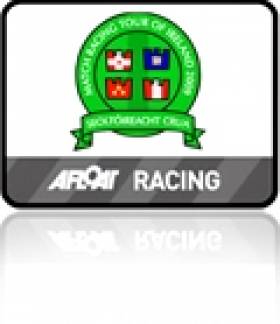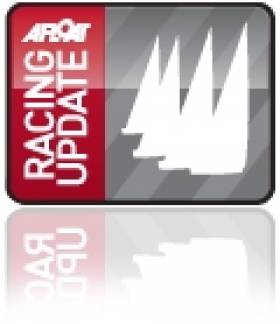Displaying items by tag: Aidan McLaverty
Day One Videos from Irish Match Racing Nationals
The Match Racing National Championships are underway in Kinsale this afternoon and we're on the water to bring you vidcasts from competitors at the Round Robin stage. Click read more and listen into George Kingston, Prof O'Connell and Aidan McLaverty.
Vidcasts by Brian Carlin
Kiwi Makes Top Start at Laser Worlds
The strong tidal current and light and at times very shifty breeze proved to be the principal challenges on the first day of the Laser World Championships off Hayling Island. It left Irish Olympic campaigner James Espey in 52nd, the top third of the senior fleet. Ronan Cull is in 152nd and Paul McMahon is 157th in the 159 boat fleet.
For those sailors who had spent the preceding days, or – for some – weeks, learning venue's nuances idiosyncrasies it was intelligence gained about the tidal current which was of immediate value.
Racing Day 1 broke the pattern of blustery winds and intermittent rain which have prevailed through pre-championships training phase, replaced absolutely on cue by bluebird skies, summer sunshine and light to moderate mainly northerly breezes.
New Zealand's Michael Bullot, runner up at last year's World Championships in Halifax, Nova Scotia made the strongest start across the two testing opening races by posting a second and a first in the first of four days of scheduled Qualifying heats.
His early statement of intent saw the Aucklander ashore this afternoon with a lead of one point over Skandia Team GBR's Paul Goodison, the Olympic and defending World Champion who opened his regatta with third place and then won his second heat by a comfortable distance.
The shifting directions of the wind, oscillating through as much as 30 degrees at times in the Standard fleet's first race set the early test, but a big 50 degrees swing early in of the second contest, kept the racers and the race team on their toes; the second and third starts were delayed until the breeze settled.
According to Goodison patience was his key virtue through both races, waiting until changes in the breeze were sufficiently established enough to make a consideredmove, rather than falling to the temptation to try and benefit every small change.
And with up to a knot of current running and the direction of flow progressively changing, flowing to the NW at the start of Race 1 and moving to the NE tactical decisions were a movable feast, rich with opportunities to make gains and losses.
Australia's double world champion Tom Slingsby, who arrived late Saturday at Hayling Island fresh from winning the Etchells World Championships with America's Cup legend John Bertrand, showed no sign of ring rustiness when he won his first heat, but he admitted to trying to breaking from the pack's conventional thinking on the first downwind of the second race, and his error dropped him four boats to score an eighth.
Among those finishing their first day with results which were well ahead of their expectations were Nicholas Heiner who won the first heat for the Yellow fleet, the biggest senior triumph yet for the young Dutch sailor who seeks to emulate or better the record of his 1996 Finn Olympic bronze medallist father, whilst Estonia's Karl-Martin Rammo paired up a third and first to match the first day 4pts tally of Goodison.
In the Junior World Championships Italy's Francesco Marrai leads the 118 boat fleet after posting a second and third. Competing for Ireland are Chris Penney, Aidan McLaverty and Hammy Baker.
Laser World Championships, Hayling Island GBR,
After Day 1
1 Michael Bullot (NZL) 1,2, 3pts
2 Paul Goodison (GBR) 3,1 4 pts
2 Karl-Martin Rammo (EST) 3,1 4pts
4 Luka Radelic (CRO) 2,2 4pts,
5 N Thompson (GBR) 2,3 5pts,
6 Pavlos Kontides (CYP) 4,3 7pts
7 Tom Slingsby (AUS) 1,8 9pts
8 Matthias Del Solar (CHI) 4,5 9pts
9 Andrew Murdoch (NZL) 6,4 10pts
10 Giacomo Bottolli (ITA) 9,4 13pts
Junior World Championships
1 Francesco Marrai (ITA) 2,3 5pts
2 Lukas Feuerherdt (GER) 1, 5 6pts
3 Thorbjoern Schierup (DEN) 3,3 6pts
4 Bogoslav Bugarin (CRO) 8,5, 13pts
5 Antony Munos (FRA) 14,2 16pts
Paul Goodison (GBR): "The first race started off in a really shifty breeze, up to 12 knots but it dropped back to five or six knots with some big swings in the wind. I think it was a bit of a patience game waiting for the wind to come back. It can be too easy to go chasing things, but the wind usually came back and so that was a bit of a patience game.
The second race got super light just before the start but at the gun there was probably 10-11 knots, that dropped to about 4-5 knots, but there was nearly a knot of tide and so it was very important to stay inside the laylines with that much of tide running. Quite a lot of the fleet got outside the port tack layline which meant them reaching in and pushing tide and that hurt them quite a lot.".
" We had three great weeks of breeze at Sail for Gold and for the two weeks since, and so here today it has been nice to remember how to do it in the light winds."
"After Sail for Gold I did three days here and then arrived her last week and have been sailing most days since then."
Andrew Maloney (NZL): "It was pretty shifty. I got a good start at the pin and then got a nice left shift and so managed to cross the fleet and from there it was just about sailing on the lifted tack and staying in the pressure on the downwind legs. It sounds easy but it wasn't!
The start and the first beat were vital and when you were out in front it got easier.
I was second at the first mark. He got back into the second left shift half way up the beat and that made the difference."
Nick Heiner (NED): "I had a really good start at the pin end, five boats from the pin and got a nice shift to the left and from there on was always ahead of the fleet, and could play with the shifts. Downwind I was not that fast, but I managed to stay ahead. But now I know what to work on for the coming days. It was a good start.
I like it here, with the current and the waves it is good fun, a bit like home in Schevenigen where I have trained a lot."
Tom Slingsby, (AUS): " I always say you can't win the regatta on the first day but you can lose and I managed not to do that which is good. It was a very tricky day with a lot of current. I got through pretty well, not as well as some but I am pretty happy with my day.
I have to say I was feeling a bit rusty on the way out to the start. Everyone else was kind of cruising around and I was racing trying to get used to it, trying to get the feel back. But all in all I sailed fine.
The first race was light, six to ten knots, I sailed quite well and rounded second and slowly caught the leader to win. The second race I was about fourth or fifth. But with the downwind the current was washing us straight across the course, I decided to take a bit of a risk and not join the train as we call it, and I broke away and unfortunately it did not work, but it could have been worse."
Karl-Martin Rammo (EST): "It was the best day of my life so far, off the charts. I managed to get in the front of the fleet early. First race I had a mediocre start but got to the front of the fleet by just sailing the shifts, I was kind of the middle but just got it right. It was so shifty and gusty.
The second race I had a really good start at the pin and tacked immediately and went pretty much to the right corner and was ahead at the upwind mark, had a mediocre downwind mark but has a good second upwind."
Nick Thompson (GBR): "All in all it was a pretty good start In the first race it was very shifty, probably averaging 10-12 knots at times but with big changes in pressure but it was nice to race in with lots of opportunities to come back. The second race was tough with strong current running which really skewed the course too much, but the race committee did a good job in moving the windward mark to square it up and so it was a decent race."






























































